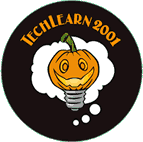Online Learning Content
A basic problem faced by the learning community is how to produce
and deliver quality content for online learning experiences. This
tutorial examines this problem.
Online learning content typically contains:
- Text, graphics, and movies
- A navigation scheme (easily a table of contents and/or buttons)
- Assessments
It may also contain collaboration tools as well as other interactive
elements and graphical elements designed to produce a unified or
branded look and feel, but the above list is basic.
To be learning content, the content should also be aware of learners.
At a minimum, learning content should recognize who the learner
is and record information about the learner's experience. To make
this possible, learning content has generally been developed in
conjunction with some sort of learning system that keeps track of
learners. Learners log on to the system and launch the content.
As the learners interact with the content, results are passed back
to the system. If the system allows it, the content can also change
its behavior based on learner information stored in the system.
For example, learners might be sent to different places in the content
based on test scores, language preferences, learning style inventories,
competencies, certifications, organizational roles, and other data.
Interoperability and Reusability
Suppose you are about to publish five hundred Web pages on broomstick
making, complete with online quizzes, pictures that move around
like the ones from Harry Potter, and lots of other cool stuff. Suddenly
physicists from the Hartz mountains discover how to make quantum
broomsticks and you need to revise your content. Fortunately
for you, the online journal of broomsticks has lots of good
material, including a short quiz on quantum effects, diagrams of
quantum handles, a video clip of the physicists, and a layman's
explanation of quantum mechanics. Better yet, the journal will sell
you the rights to use it all for $5. Sounds like a bonanza, right?
WRONG!
- Your 500 pages have a navigational scheme that consists of "back"
and "next" buttons. Most of these links are hard-coded,
so inserting new material requires lots of tedious editing.
- Some of of the buttons take the learner to different places
depending on quiz scores. These require communication with your
learning system. The online journal of broomsticks used a different
system, so those parts have to be reprogrammed completely.
- The online journal uses its own delivery engine for the quiz
and passes the results back in its own format to its own database.
You can forget about using the quiz at all.
- The diagram on quantum handles is an ordinary jpeg. You need
hpegs that move like the pictures in Harry Potter, and starting
with a jpeg doesn't save much work.
These are issues of interoperability (content from multiple sources
working equally well with different learning systems) and reusability
(content developed in one context being transferable to another
context). Interoperability and reusability are imperative to the
sustainability of your work. Without them, anyone with a significant
investment in either content or a learning system is locked in to
that particular content or system. Without them, every time a course,
(what is this?) or an interactive electronic training manual needs
to be updated, far more of the material must be rewritten than is
necessary or desirable. Without them, the process of developing
high-quality content is prone to unnecessary duplication of effort,
driving up the cost, possibly past what the market will bear.
Reusable Learning Objects
Reusable learning objects represent an alternative approach to
content development. In this approach, content is broken down into
chunks. From a pedagogical perspective, each chunk might play a
specific role within an instructional design methodology. The requirements
for each chunk are
- Each chunk must be able to communicate with learning systems
using a standardized method that does not depend on the system
- What happens within a chunk is the chunk's business.
- How a learner moves between chunks is controlled by the
learning system.
- Each chunk must have a description that enables designers to
search for and find the right chunk for the right job.
Such chunks are called learning objects. There is no standard for
the size (or granularity) of a learning object. Larger learning
objects are typically harder to reuse, and smaller learner objects
save less work for those who are reuse them. Per the literature
of pedagogy, the happy medium has been estimated as between five
and fifteen minutes of learning material.
The table of pros and cons in the following section summarizes
some of the advantages and disadvantages of the learning object
approach to developing content.
|
